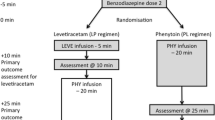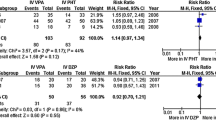Abstract
Background: Status epilepticus is a medical emergency associated with significant morbidity and mortality.
Objective: To report our experience with the use of intravenous (IV) levetiracetam in patients with status epilepticus who had not responded to IV benzodiazepines.
Methods: A retrospective review of the clinical charts of patients with status epilepticus who were treated with IV levetiracetam from July 2007 to July 2008 in our department was performed. Data on demographics, epileptic syndrome, aetiology, treatment dosage and adverse effects were analysed. IV levetiracetam was administered over a period of 15–30 minutes; each 500 mg of levetiracetam was diluted in 100 mL of normal saline.
Results: Thirty-four patients (19 men and 15 women, 11–90 years old) with status epilepticus were treated with IV levetiracetam. Six patients (18%) had primarily generalized status epilepticus and 28 (82%) had focal status epilepticus. The aetiologies were: vascular (47%), cryptogenic (24%), tumours (12%), metabolic (12%) and brain anoxia (6%). The indications for administering IV levetiracetam were: no response to IV phenytoin and/or IV valproic acid (53% of patients) or to avoid adverse effects, contraindications or potential interactions (47% of patients). The median loading dose of IV levetiracetam was 1000 mg and the maintenance dosage ranged from 500 to 1500mg/12 hours (median 1000mg/12 hours). Status epilepticus stopped in a clear temporal relationship with IV levetiracetam in 71% of patients. IV levetiracetam was especially effective in older patients with vascular status epilepticus, while cryptogenic status epilepticus, primarily generalized status epilepticus, previous therapy with IV phenytoin and/or valproic acid and status epilepticus due to brain anoxia were associated with a poor response. There were no serious adverse events documented in the patients’ charts.
Conclusions: While waiting for large, controlled studies, our data suggest that IV levetiracetam might be an alternative for the treatment of status epilepticus, especially in elderly patients with vascular status epilepticus and concomitant medical conditions.


Similar content being viewed by others
References
Lowenstein DH, Alldredge BK. Current concepts: status epilepticus. N Engl J Med 1998; 338: 970–5
Treiman DM, Meyers PD, Walton NY, et al. A comparison of four treatments for generalized status epilepticus: Veterans Affairs Status Epilepticus Cooperative Study Group. N Engl J Med 1998; 339: 792–8
De Smedt T, Raedt R, Vonck K, et al. Levetriracetam: part II. The clinical profile of a novel anticonvulsant drug. CNS Drug Rev 2007; 13: 57–78
Lynch BA, Lamberg N, Nocka K, et al. The synaptic vesicle protein SV2A is the binding site for the antiepileptic drug levetiracetam. Proc Natl Acad Sci U S A 2004; 101: 9861–6
Patsalos PN. Pharmacokinetic profile of levetiracetam: toward ideal characteristics. Pharmacol Ther 2000; 85: 77–85
French JA, Arrigo C. Rapid onset of action of levetiracetam in refractory patients. Epilepsia 2005; 46: 324–6
Sirsi D, Safdieh JE. The safety of levetiracetam. Expert Opin Drug Saf 2007; 6: 241–50
Ruegg S, Naegelin Y, Harmeier M, et al. Intravenous levetiracetam: treatment experience with the first 50 critically ill patients. Epilepsy Behav 2008; 12: 477–80
Knake S, Gruener J, Hattemer K, et al. Intravenous levetiracetam in the treatment of benzodiazepine refractory status epilepticus. J Neurol Neurosurg Psychiatry 2008; 79: 588–9
Moddel G, Bunten S, Dobis C, et al. Intravenous levetiracetam: a new treatment alternative for refractory status epilepticus. J Neurol Neurosurg Psychiatry 2009; 80: 689–92
Szaflarski JP, Meckler JM, Szaflarski M, et al. Levetiracetam use in critically ill patients. Neurocritical Care 2007; 7: 140–7
Rossetti AO, Bromfield EB. Determination of success in the use of oral levetiracetam in status epilepticus. Epilepsy Behav 2006; 8: 651–4
Rupprecht S, Franke K, Fitzek S, et al. Levetiracetam as a treatment option in non-convulsive status epilepticus. Epilepsy Res 2007; 73: 238–44
Patel NC, Landan IR, Levin J, et al. The use of levetiracetam in refractory status epilepticus. Seizure 2006; 15: 137–41
Acknowledgements
No sources of funding were used to assist in the preparation of this study. The authors have no conflicts of interest that are directly relevant to the content of this study.
Author information
Authors and Affiliations
Corresponding author
Rights and permissions
About this article
Cite this article
Gámez-Leyva, G., Aristín, J.L., Fernández, E. et al. Experience with Intravenous Levetiracetam in Status Epilepticus. CNS Drugs 23, 983–987 (2009). https://doi.org/10.2165/11311100-000000000-00000
Published:
Issue Date:
DOI: https://doi.org/10.2165/11311100-000000000-00000




